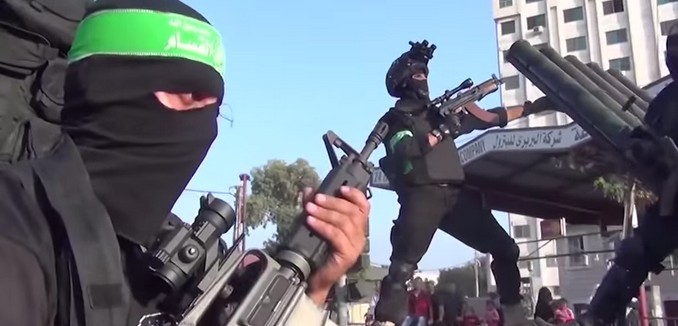An investigation into the Associated Press’s news coverage of last summer’s war between Israel and Hamas found that an AP report published last month analyzing the death toll in Gaza was “botched in just about every imaginable way.”
In an article for The New York Observer published Tuesday, journalists Richard Behar and Gary Weiss found that the news organization regularly violated fundamental principles of journalism, as well as its own internal guidelines, to create a narrative implying Israel’s responsibility for civilian deaths in Gaza.
In a quick overview of some of the problems with the AP’s approach, the authors wrote:
Some of it is Journalism 101 stuff, such as failing to write accurate headlines and failing to fully and fairly quote a principal source on a crucial issue. A lead photograph simultaneously exploited a 6-year-old child while inadequately identifying his father—a Hamas commander—as a “Hamas policeman.” And correcting captions violating its ethics rules only after we brought the issue to the AP’s attention—but limiting those corrections to an archive not usually accessed by the public, rather than the articles themselves.
A video segment, released concurrently, was even worse, and was structured almost as a kind of multimedia argument for bringing Israel to the International Criminal Court for war crimes, using as its principal source a fervent critic of Israel.
Though this isn’t a complete list of criticisms, the identification of a Hamas terrorist as merely a policeman is emblematic of the problems Behar and Weiss found in the AP’s reporting. After noting that it had been reported in 2010 that “the Hamas Interior Ministry formally incorporated a significant percentage of the police force into the Hamas military wing,” Behar and Weiss pointed out that though the AP had resources available to help them portray the issues accurately, it did not utilize them.
If the AP had wanted to find out if Mr. Malakeh was an exception to the rule, it had a number of options at its disposal. The Israeli armed forces is one source of information. Libby Weiss (no relation to one of the coauthors), head of the North American media desk for the Israel Defense Forces (IDF), told us that “Mostafa Jamal Malakeh, born in 1983, was part of the Hamas rocket apparatus in Zeitoun, and was responsible for firing rockets into various areas in Israel.”
Hamas is another source of information. We don’t know how Hamas would respond to such an inquiry, but we do know that it implicitly acknowledged that he was a fighter and not a civilian: His name does not appear on Gaza casualty lists, whether the ones in Arabic or the ones in English, such as one from the International Middle East Media Center. The latter includes Malakeh’s wife and one child (spelled “Malaka” on the list).
The Observer was advised of the foregoing by another logical source to interview, Reuven Erlich, a retired IDF intelligence officer who now heads the Meir Amit Intelligence and Terrorism Information Center—an independent research institute that collects, studies and disseminates information about terrorists. Mr. Erlich points out that Hamas fighters such as Malakeh were omitted from casualty lists generated by Hamas-affiliated agencies, even though his wife and child were on such lists.
The failure to indentify Malakeh accurately, according to Behar and Weiss, “raises a question that goes to the heart of the AP article: Did the news agency accurately distinguish between Hamas fighters and civilians?”
In other instances, the AP talked to Israeli sources and cherry-picked which details of those interviews they actually reported.
Among problems Behar and Weiss documented include using posed photos and uncritically citing sources whose views are demonstrably biased.
The authors announced that they were launching a new initiative to combat inaccurate reporting on the Middle East. Behar had previously written an article for Forbes covering a number of the problems that he and Weiss found with last month’s AP report.
Behar and Weiss’s observations are consistent with an observation in a recently released report by the Jewish Institute for National Security Affairs that Hamas relies upon “widespread misunderstanding of [the laws of armed conflict] not just among warring parties but also media, observers and the international public – a misunderstanding built on the false assumption that the law prohibits the infliction of any and all civilian casualties.”
In a series of articles for The Atlantic and Tablet Magazine, former AP reporter Matti Friedman charged that the Associated Press, and Israel-based media outlets and NGOs more generally, were complicit in promoting Hamas’ media strategy.
Another former AP reporter, Mark Lavie, wrote in Why Everything Reported from Gaza is Crazy, Twisted, which was published in the August 2014 issue of The Tower Magazine:
Journalists, of course, won’t tell you what you’re missing in the coverage. Their anchors or editors won’t tell you why large parts of the story are colored a certain way or taken from a certain angle. They don’t want to put their reporters’ lives at risk.
This is the main reason that video and pictures seem to flow freely out of Gaza. But critical elements of the story itself can’t, and neither can all the pictures and video. It gives the impression that the story is being covered, when only part of it—sometimes a small part—is being covered.
All we can do is keep this in mind: the world does not operate according to our democratic standards of freedom of the press. What we see may not be the whole truth. In fact, you can be sure it isn’t.
[Photo: Israel Defense Forces / YouTube ]




